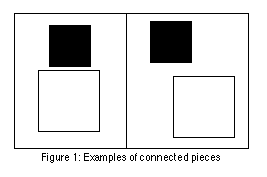
OVERVIEW
Igloo is a turn-based game for 2 players (or 2 teams) which can be played on any flat, stable surface. The game uses a standard set of Icehouse pieces and is set up in a similar manner, with the pieces starting out in stash zones that are not part of the playing field. Each player plays a single piece during each turn. The game ends after all pieces have been played.
Each player controls 2 sets of pyramids. However, only one set of pyramids will be worth points at the end of the game. The other set are decoys. Trying to figure out which is which, from the player's style of play and skill at bluffing, adds a level of intrigue to the game.
PLACEMENT RULES
The player who goes first places a piece in the center of the table.
Whenever a new piece is played, it must be aligned with the pieces already in play such that its sides are either parallel with or perpendicular to the sides of all other pieces played. (In other words, if you were playing on a piece of fine grid graph paper and you viewed the playing area from above, all pieces in play should line up nicely with the little squares on the graph paper.)
Additionally, each new piece played must make a connection to at least one piece already in play. To be connected, a pair of pieces must meet the following conditions:
a) they must be closer to each other than the width of a small Icehouse piece;
b) their parallel sides must overlap, at least slightly.
Figure 1 below shows 2 examples of pieces that are connected.

| Figure 2 shows an example of a pair of pieces that are too far away from each other to be connected. (Note that both of the black pieces are connected to the white piece even though they are not connected to each other.) |  |
 |
The pieces shown in Figure 3 are also not connected, since they do not have any parallel sides that overlap. |
CAPTURING PIECES
The object of the game is to capture as many of your opponents pieces as possible. The winner is the player with the most points worth of captured pieces (large=3, medium=2, small=1). Captured pieces are removed from play and set aside for scoring at the end.
To capture a piece, a player must make a certain number of connections with his or her pieces to the piece they wish to capture. However, if the target piece is connected to any pieces belonging to the target piece's owner, then that piece is said to be supported, and is more difficult to capture. The connections required to make a capture are shown below.
| Size | Unsupported | Supported |
| small | 1 | 2 |
| medium | 2 | 3 |
| large | 3 | 4 |
Additionally, there must be more points worth of enemy pieces making connections to the target piece than the target piece's point value. Example: an unsupported one point piece cannot be captured by a solitary one point piece (although it can be captured by a 2 pointer).
In general, a player may not place a piece into harm's way. That is, a piece cannot be played in such a way as to make it immediately open to capture by the enemy.
The exception to the above rule is the case in which, by placing one piece into a dangerous spot, a player creates a situation in which pieces belonging to both players are open to capture. This situation is called a Double Threat. In this case, it is the aggressor (i.e. the person who played the piece that created the Double Threat) who gets to make the capture.
If, after one piece has been captured, it is the case that another piece is open to capture, the player may carry out that capture as well. This could be an additional capture for the aggressor, or it could be a capture by the enemy, in the aftermath of a Double Threat which still leaves the aggressor's piece open to capture. (Note that in general, a player captures a piece as soon as he makes a play which creates enough connections to permit the capture; but in this latter case, the enemy may make a capture before starting his turn.)
DECOYS
Each player will have 30 pieces, 15 each of 2 different colors. Before the game starts, each player will secretly write down the color that will be worth points at the end of the game.
When determining if you can capture an enemy piece, each player's pair of colors can be thought of as being a single color. The key is simply to distinguish your pieces from those of your enemy.
After the last piece has been played and it is clear that no more pieces may be captured, both players reveal which color was the valuable color. Only captured pieces of that color are worth points. The player with the highest score wins.
FOUR PLAYER TEAM VARIATION
To play Igloo with 4 people, divide the players into 2 teams. The team
members will sit across from each other, with each player controlling all
of the pieces of a single color. Before starting the game, the team members
will privately confer and decide which player will control the real pieces
and which will control the decoys. Play then proceeds as normal. There are
no rules governing table talk; players are free to speculate openly with
each other about which color they think is the real color, etc.